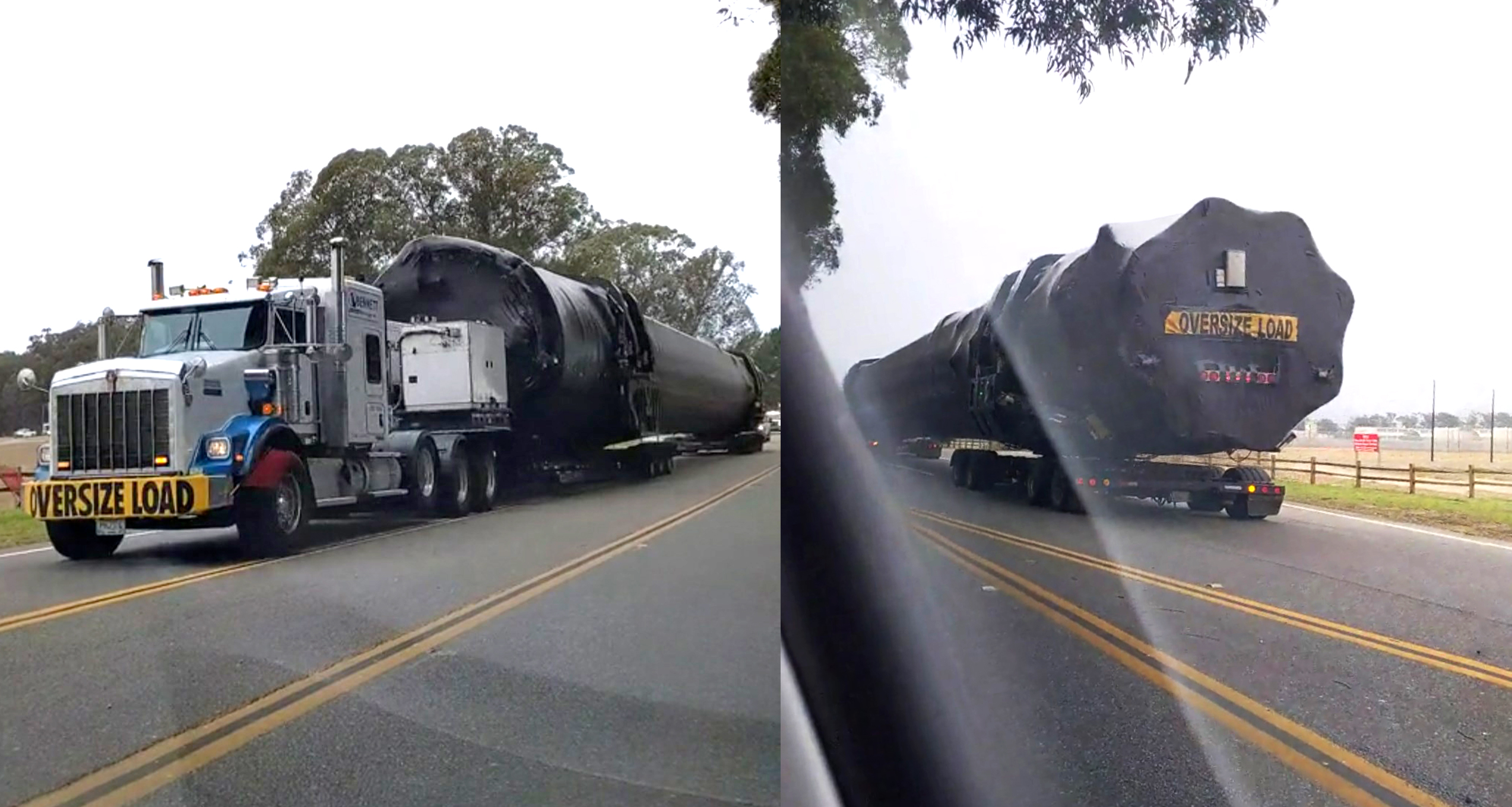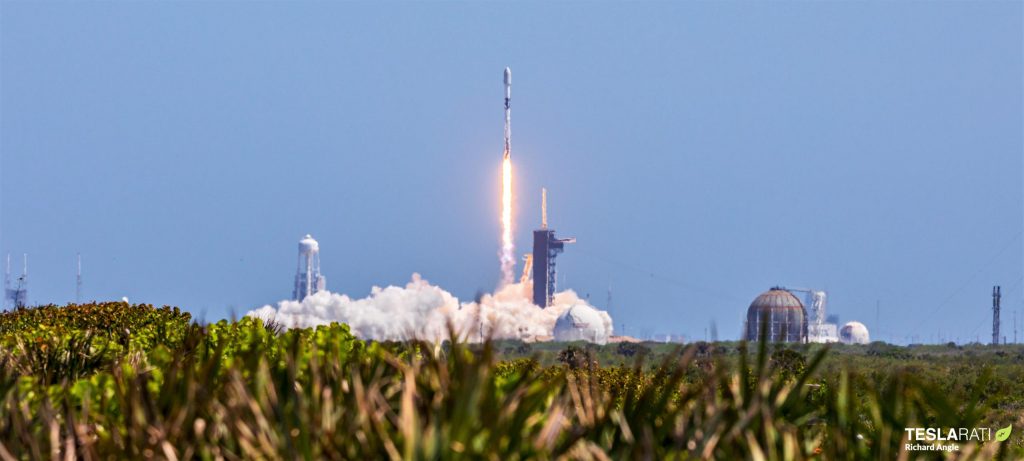

News
SpaceX sends reused Falcon 9 booster west for first California Starlink launches
SpaceX has shipped the first of one or two flight-proven Falcon 9 boosters from Florida to California in the latest sign that the company is preparing to begin dedicated polar Starlink launches in the near future.
On May 27th, a Reddit post revealed a Falcon 9 booster arriving at Vandenberg Air/Space Force Base (VAFB), the home of SpaceX’s West Coast SLC-4E launch pad. Only truly useful for polar or high-inclination launches with satellites that need to orbit the Earth’s poles instead of the equator, SpaceX has only used SLC-4E twice in the last two years – once in June 2019 and most recently in November 2020.
Now, amidst a major hiring spree and rare new activity at a nearby Los Angeles port, SpaceX is clearly gearing up to return its SLC-4E launch pad to active duty.
B1049 began its career in Florida (Telstar 18V), moved to Vandenberg for its second flight (Iridium-8), went back to Florida for seven Starlink missions, and is once again returning to the best coast.— Michael Baylor (@nextspaceflight) May 27, 2021

Both recent West Coast Falcon 9 missions hosted booster landings at LZ-4, a landing zone situated a little over 1000 feet (300m) away from the launch pad. That freed up SpaceX to ship former West Coast drone ship Just Read The Instructions (JRT) across the Panama Canal in August 2019, where it ultimately joined the company’s Florida rocket recovery fleet in early 2020 to support a major launch cadence ramp.
As a partial result, SpaceX was able launch Falcon 9 26 times in 2020, beating the previous record – 21 flights – by almost a quarter. In 2021, SpaceX is well on its way to smashing that annual launch record again and has completed 16 orbital launches with seven full months left in the year. That cadence is pushing SpaceX’s launch pads, recovery ships, and booster fleet to their limits. Due to the voracious demands of SpaceX’s almost weekly launch cadence, the company would only be shipping a workhorse booster to Vandenberg if there was a pressing need for it.
Said to be Falcon 9 B1049 by Next Spaceflight and NASASpaceflight reporter Michael Baylor, the booster that arrived at Vandenberg Air Force Base on Thursday has flown nine times – two of which it completed in February and May 2021. B1049 hasn’t been the most rapidly reusable of the fleet and is the oldest Falcon booster still operational after debuting in September 2018. However, SpaceX’s SLC-4E is relatively old itself and recruiting documents distributed as recently as 2021 indicated that the company’s West Coast resurgence was targeting a maximum cadence of one launch per month.
Virtually all of those missions will carry the company’s own Starlink satellites. On Wednesday, May 26th, SpaceX completed its 28th operational East Coast Starlink launch, effectively completing the first ‘tranche’ of the constellation once the satellites already in space reach their operational orbits. In April, SpaceX COO and President Gwynne Shotwell stated that polar Starlink launches would begin not long after that 28-launch milestones.
The day before B1049 arrived, SpaceX filed the first regulatory documents for at least six Vandenberg Starlink launches between July 2021 and January 2022 – one mission per month. It’s hard to say when the first launch will come. With B1049 now on site, FCC permits in work, and a new berth lease active in Port of Long Beach, the only real piece of the equation missing is a drone ship to support polar Starlink launches. According to said FCC documents, SpaceX will continue to push Falcon 9 to its limits on the West Coast, recovering boosters 640 km (~400 mi) downrange after polar Starlink launches.
SpaceX’s two operational drone ships – OCISLY and JRTI – currently have their hands full on the East Coast. Transporting either to California will take several weeks, limiting SpaceX’s East Coast launch cadence during that period. SpaceX and its contractors are currently hard at work completing a third drone ship – A Shortfall of Gravitas (ASOG), but past experience suggests that the vessel is at least a few months away from completion.
Once a drone ship has arrived at SpaceX’s new West Coast docks, though, the company will have almost everything it needs to kick off polar Starlink launches.

News
Tesla starts showing how FSD will change lives in Europe
Local officials tested the system on narrow country roads and were impressed by FSD’s smooth, human-like driving, with some calling the service a game-changer for everyday life in areas that are far from urban centers.

Tesla has launched Europe’s first public shuttle service using Full Self-Driving (Supervised) in the rural Eifelkreis Bitburg-Prüm region of Germany, demonstrating how the technology can restore independence and mobility for people who struggle with limited transport options.
Local officials tested the system on narrow country roads and were impressed by FSD’s smooth, human-like driving, with some calling the service a game-changer for everyday life in areas that are far from urban centers.
Officials see real impact on rural residents
Arzfeld Mayor Johannes Kuhl and District Administrator Andreas Kruppert personally tested the Tesla shuttle service. This allowed them to see just how well FSD navigated winding lanes and rural roads confidently. Kruppert said, “Autonomous driving sounds like science fiction to many, but we simply see here that it works totally well in rural regions too.” Kuhl, for his part, also noted that FSD “feels like a very experienced driver.”
The pilot complements the area’s “Citizen Bus” program, which provides on-demand rides for elderly residents who can no longer drive themselves. Tesla Europe shared a video of a demonstration of the service, highlighting how FSD gives people their freedom back, even in places where public transport is not as prevalent.
What the Ministry for Economic Affairs and Transport says
Rhineland-Palatinate’s Minister Daniela Schmitt supported the project, praising the collaboration that made this “first of its kind in Europe” possible. As per the ministry, the rural rollout for the service shows FSD’s potential beyond major cities, and it delivers tangible benefits like grocery runs, doctor visits, and social connections for isolated residents.
“Reliable and flexible mobility is especially vital in rural areas. With the launch of a shuttle service using self-driving vehicles (FSD supervised) by Tesla in the Eifelkreis Bitburg-Prüm, an innovative pilot project is now getting underway that complements local community bus services. It is the first project of its kind in Europe.
“The result is a real gain for rural mobility: greater accessibility, more flexibility and tangible benefits for everyday life. A strong signal for innovation, cooperation and future-oriented mobility beyond urban centers,” the ministry wrote in a LinkedIn post.
News
Tesla China quietly posts Robotaxi-related job listing
Tesla China is currently seeking a Low Voltage Electrical Engineer to work on circuit board design for the company’s autonomous vehicles.

Tesla has posted a new job listing in Shanghai explicitly tied to its Robotaxi program, fueling speculation that the company is preparing to launch its dedicated autonomous ride-hailing service in China.
As noted in the listing, Tesla China is currently seeking a Low Voltage Electrical Engineer to work on circuit board design for the company’s autonomous vehicles.
Robotaxi-specific role
The listing, which was shared on social media platform X by industry watcher @tslaming, suggested that Tesla China is looking to fill the role urgently. The job listing itself specifically mentions that the person hired for the role will be working on the Low Voltage Hardware team, which would design the circuit boards that would serve as the nervous system of the Robotaxi.
Key tasks for the role, as indicated in the job listing, include collaboration with PCB layout, firmware, mechanical, program management, and validation teams, among other responsibilities. The role is based in Shanghai.
China Robotaxi launch
China represents a massive potential market for robotaxis, with its dense urban centers and supportive policies in select cities. Tesla has limited permission to roll out FSD in the country, though despite this, its vehicles have been hailed as among the best in the market when it comes to autonomous features. So far, at least, it appears that China supports Tesla’s FSD and Robotaxi rollout.
This was hinted at in November, when Tesla brought the Cybercab to the 8th China International Import Expo (CIIE) in Shanghai, marking the first time that the autonomous two-seater was brought to the Asia-Pacific region. The vehicle, despite not having a release date in China, received a significant amount of interest among the event’s attendees.
Elon Musk
Elon Musk and Tesla AI Director share insights after empty driver seat Robotaxi rides
The executives’ unoccupied tests hint at the rapid progress of Tesla’s unsupervised Robotaxi efforts.

Tesla CEO Elon Musk and AI Director Ashok Elluswamy celebrated Christmas Eve by sharing personal experiences with Robotaxi vehicles that had no safety monitor or occupant in the driver’s seat. Musk described the system’s “perfect driving” around Austin, while Elluswamy posted video from the back seat, calling it “an amazing experience.”
The executives’ unoccupied tests hint at the rapid progress of Tesla’s unsupervised Robotaxi efforts.
Elon and Ashok’s firsthand Robotaxi insights
Prior to Musk and the Tesla AI Director’s posts, sightings of unmanned Teslas navigating public roads were widely shared on social media. One such vehicle was spotted in Austin, Texas, which Elon Musk acknowleged by stating that “Testing is underway with no occupants in the car.”
Based on his Christmas Eve post, Musk seemed to have tested an unmanned Tesla himself. “A Tesla with no safety monitor in the car and me sitting in the passenger seat took me all around Austin on Sunday with perfect driving,” Musk wrote in his post.
Elluswamy responded with a 2-minute video showing himself in the rear of an unmanned Tesla. The video featured the vehicle’s empty front seats, as well as its smooth handling through real-world traffic. He captioned his video with the words, “It’s an amazing experience!”
Towards Unsupervised operations
During an xAI Hackathon earlier this month, Elon Musk mentioned that Tesla owed be removing Safety Monitors from its Robotaxis in Austin in just three weeks. “Unsupervised is pretty much solved at this point. So there will be Tesla Robotaxis operating in Austin with no one in them. Not even anyone in the passenger seat in about three weeks,” he said. Musk echoed similar estimates at the 2025 Annual Shareholder Meeting and the Q3 2025 earnings call.
Considering the insights that were posted Musk and Elluswamy, it does appear that Tesla is working hard towards operating its Robotaxis with no safety monitors. This is quite impressive considering that the service was launched just earlier this year.








